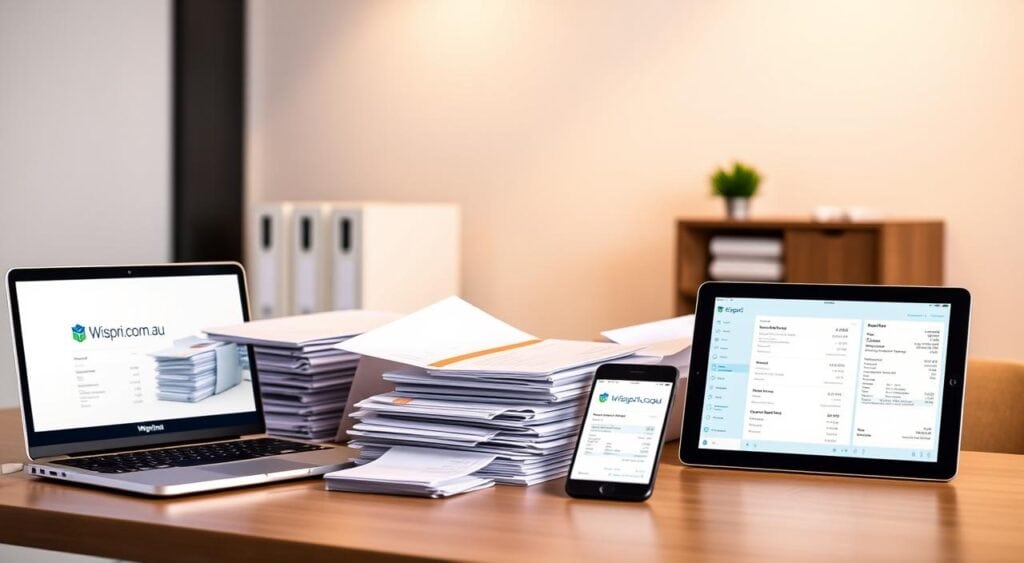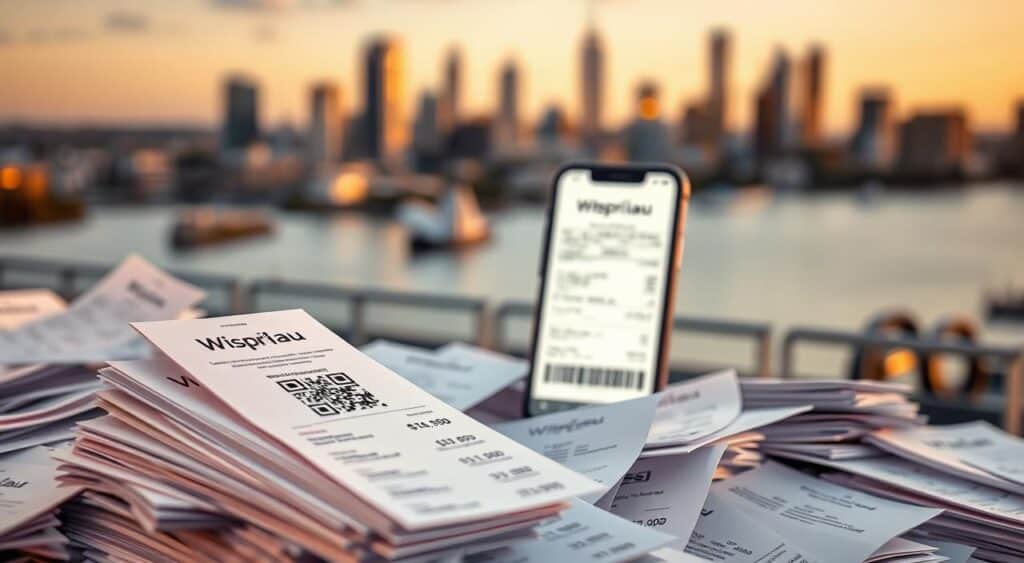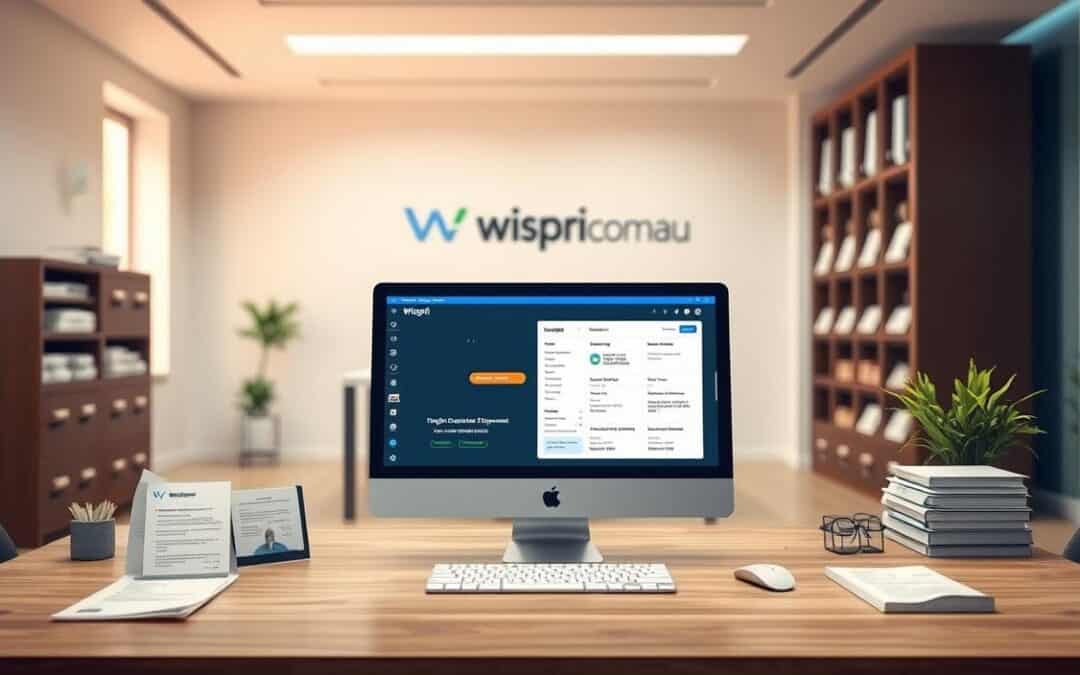Did you know Aussie shoppers lose over $1,200 yearly by missing the best purchase timing? Worse yet, 73% of online “sales” don’t actually cut prices. Keeping track of purchases and paperwork shouldn’t add to the stress. That’s where smarter organisation steps in.
Storing paper receipts for tax time often feels like herding cats. They pile up, fade, or vanish when you need them most. The ATO requires keeping business expense records for five years minimum – a tough ask with physical copies. But what if you could ditch the shoebox method?
More Australians now use cloud-based tools to track warranties, expenses, and purchases. Platforms like Wispri go beyond price alerts – they help you monitor spending patterns and store purchase histories. This isn’t just about tidiness. It’s about having instant access to proof of purchase during tax audits or warranty claims.
Going paperless means less clutter and quicker tax prep. Imagine finding any receipt in seconds, even years later. Plus, cloud storage keeps your records safe from coffee spills or lost wallets. Ready to transform how you handle purchases?
Key Takeaways
- ATO rules require keeping business expense records for at least five years
- Cloud storage reduces physical clutter and protects against lost documents
- Price-tracking tools help verify genuine sales and store purchase histories
- Instant receipt access simplifies tax preparation and warranty claims
- Digital systems provide better security than paper-based methods
Understanding Digital Receipts Management
Tired of hunting through drawers for that missing purchase proof? Modern solutions turn chaotic paperwork into searchable files. With 82% of Aussies now using smartphones for financial tasks, it’s easier than ever to ditch the paper chase.

Your Financial Control Centre
AI-powered tools automatically sort purchases by date, category, or retailer. Custom alerts remind you about warranty expirations or tax deadlines. One user reported: “I reclaimed $460 in forgotten GST claims last quarter using automated tracking.”
For business owners, every valid tax document needs GST details. Lose one receipt, and you could miss claiming $29 back per $300 spent. Cloud storage keeps these records intact for the ATO’s five-year rule – no faded ink or coffee stains.
Tax Time Made Simple
Search “work laptop” or “July 2023” to instantly pull related files. Integrated dashboards show spending patterns, helping trim unnecessary costs. Sync with accounting software to slash data entry errors by up to 67%.
Security matters. Encrypted systems protect your information better than that kitchen drawer. Whether you’re claiming work expenses or tracking personal budgets, organised records mean faster refunds and fewer audit headaches.
The Rise of Digital Receipts in Australia
Australian shoppers are swapping paper for pixels as electronic purchase records become the new norm. Major retailers like JB Hi-Fi and Officeworks now send proof of purchase directly to your email, while platforms like Wispri track spending across Amazon Australia, eBay, and Bunnings in real time.

Evolving Trends in Receipt Storage
Three years ago, only 38% of Aussie stores offered email receipts. Today, that figure tops 72% according to recent retail surveys. Improved smartphone cameras and scanning apps let you capture paper slips instantly – no more faded thermal prints come tax season.
Small businesses benefit too. Cloud-based systems automatically sort expenses by date or supplier. “I save 3 hours weekly since switching to app-based tracking,” shares Sarah, a Melbourne café owner. This shift accelerated during COVID, when contactless payments became essential.
| Feature | Paper Receipts | Electronic Records |
|---|---|---|
| Accessibility | Physical storage required | Cloud access anywhere |
| Durability | Fades in 6-12 months | Lasts indefinitely |
| Search Time | 15+ minutes average | Under 10 seconds |
| Environmental Impact | 12kg paper waste/year | Zero physical waste |
Beyond convenience, this change supports sustainability goals. Harvey Norman estimates they’ve saved 47 tonnes of paper annually since introducing digital options. For shoppers, it means having warranty details handy when your washing machine breaks down – no frantic drawer searches required.
Tools like Wispri take it further by analysing your spending data across retailers. Spot price trends, track warranties, and never lose a tax document again. As one Sydney accountant notes: “Clients with organised e-records claim 23% more deductions on average.”
How Wispri Enhances Price Tracking and Savings
Ever bought something “on sale” only to find it’s cheaper elsewhere next week? Wispri’s smart tools help you beat these frustrations. By combining price history with your purchase records, this Aussie-developed platform turns guesswork into strategy.
![]()
AI-Powered Price Monitoring and Customisable Alerts
Wispri’s AI scans prices across JB Hi-Fi, Amazon Australia, and 200+ retailers. Set alerts for specific products, and get notified when prices truly drop – not just during fake “sales”. One user saved $189 on a fridge by waiting for Wispri’s green light: “The app spotted a 31% price dip two days after a ‘limited offer’ ended.”
The system links directly to your purchase records. Every alert includes historical data showing price trends over 90 days. No more wondering if today’s deal is genuine.
Wispri PRO Features for Advanced Users
Power users upgrade to PRO for deeper insights. Track spending categories, compare retailers, and export data to accounting tools. Extended price histories (up to 2 years) help negotiate refunds if items get discounted post-purchase.
PRO’s dashboard highlights your best-saving months and frequently used stores. Sync it with your preferred filing system to auto-match receipts with price drops. Early adopters report saving 19% more annually by combining these features.
Best part? The free version covers essentials. Whether you’re budgeting for a BBQ or business supplies, Wispri keeps your spending sharp and records tidy.
Managing Your Digital Receipts Effectively
Imagine having all your purchase records at your fingertips in seconds. With smart organisation, you can turn scattered files into a searchable library that works for you – not against you.
Steps to Organise and Store Your Digital Copies
Start by creating folders sorted by month or expense type – “Work Gear July” or “Home Appliances” work well. Use clear file names like “Bunnings_15July_$89” for instant recognition. Snap photos with your phone’s camera in natural light, ensuring text stays readable.
Automation saves hours. Apps can rename files and sort them into cloud storage automatically. One tradie shared: “My GST claims now take 20 minutes instead of 3 hours weekly.” Sync across devices so your desktop and phone show the same updated records.
Setting Up a User-Friendly Dashboard
Customise your main screen to display frequent categories like “Tax Deductibles” or “Warranties”. Colour-code urgent items and pin recent purchases up top. Most tools let you search by retailer, date, or amount – no more endless scrolling.
Link your system to accounting software for real-time updates. Weekly backups to external drives add extra security. With everything in its place, you’ll tackle tax time or warranty claims before the kettle boils.
Tools and Techniques for Digital Receipts Management
What if your phone could file purchase proofs faster than you brew coffee? Modern apps and cloud systems turn receipt chaos into searchable order. Whether you’re tracking business expenses or personal budgets, the right tools save hours and prevent “where’s that slip?” panic.
Smart Scanning Meets Smart Storage
Free options like the ATO’s myDeductions app let you snap receipts and auto-send data to myGov. For deeper accounting integration, MYOB’s Capture App syncs with Business and AccountRight platforms. One bookkeeper shared: “QuickBooks’ scanning tool cut my client’s admin time by 40% last tax season.”
Specialised apps take it further:
- Expensify: Scans, categorises, and creates reports in one tap
- Dext: Extracts GST details using AI-powered OCR
- Receipt Bank: Auto-files emailed purchase confirmations
Cloud platforms offer varied strengths:
| Service | Best For | Integration |
|---|---|---|
| Google Drive | Quick searches | Links with Xero |
| Dropbox | Large files | Works with FreshBooks |
| OneDrive | Microsoft users | Syncs with MYOB |
Set up email rules to auto-sort e-receipts into folders. Combine this with weekly scans using your phone’s camera – just ensure good lighting. As one Sydney tradie noted: “Since using both email filters and Dext, I’ve claimed $1,100 in missed deductions.”
Avoiding Pitfalls and Detecting Fake Sales
Caught in a ‘limited-time offer’ that wasn’t really a deal? Savvy shoppers know flashy promotions don’t always mean savings. Let’s explore how to spot genuine bargains and keep your purchase records audit-ready.
Your Secret Weapon Against Marketing Tricks
Wispri’s price history feature reveals truth behind sale tags. The platform tracks items across 200+ Aussie retailers, showing whether today’s “50% off” beats last month’s regular pricing. “I avoided three fake sales last quarter using their 90-day graphs,” shares Mark, a Brisbane renovator.
Quality scans matter. Blurry images missing GST details or dates can void tax claims. Follow this checklist for valid records:
| Essential Details | Common Errors | Fix |
|---|---|---|
| Retailer name & ABN | Cropped logos | Capture full receipt width |
| Transaction date | Faded thermal print | Scan immediately |
| Payment method | Missing last 4 card digits | Check back of slip |
| Total including GST | Glare obscures numbers | Use natural light |
ATO requires keeping business records for five years. Store files in two cloud locations like Google Drive and Dropbox. Test access yearly – a Sydney accountant recently found 12% of clients couldn’t open old PDFs.
Watch for these fake sale tactics:
- Inflated “original” prices before discounts
- Short-term offers reappearing monthly
- Vague terms like “selected items only”
Wispri users save 17% more annually by waiting for genuine dips. With organised data and smart alerts, you’ll shop smarter and sleep easier come tax time.
Integrating Digital Receipts with Accounting and Expense Tracking
What if your accounting software could file purchase records before you finish your morning coffee? Modern systems bridge the gap between shopping and bookkeeping, turning scattered files into organised data streams. Platforms like MYOB and FreshBooks let you email proofs directly into expense reports – no more manual typing or lost paperwork.
Linking Receipts to Your Expense Reports
Forward e-receipts to your accounting tool’s dedicated email address. MYOB users find this unique inbox in their account’s upload section. FreshBooks’ smart scanner reads attachments automatically, matching them to existing transactions. One café owner noted: “It cut our admin errors by half during busy periods.”
Syncing with Your Favourite Accounting Software
Connect apps like Xero or QuickBooks to auto-sort costs by project or tax category. Weekly syncs update reports across devices. Set rules to flag GST items or overdue invoices. Small businesses using these links save 3-5 hours weekly on data entry alone.
With everything connected, tax-ready summaries build themselves. Expense claims? Submitted before your tea goes cold.
FAQ
How do digital receipts help with tax records?
They automatically store purchase details like date, amount and vendor, making it easier to claim deductions or handle audits. Linking them to accounting tools like Xero or QuickBooks saves time during tax season.
What’s the best way to store digital copies of receipts?
Use cloud-based apps like Dropbox or Google Drive for secure backups. Pair these with receipt-scanning tools such as Wispri to organise files by category, date or project for quick access.
Can I link digital receipts to expense reports?
Yes! Platforms like Wispri let you attach files directly to expense entries. This syncs with software like MYOB, reducing manual data entry and improving accuracy for business claims.
How do I avoid losing paper warranties?
Take a photo or scan warranty documents and upload them to a dedicated folder in your cloud storage. Add reminders for expiry dates so you never miss a claim window.
Are digital receipts accepted by the ATO?
Absolutely. The Australian Taxation Office recognises them if they include transaction details, supplier info and payment method. Keep backups for at least five years to stay compliant.
What features should I look for in receipt-scanning apps?
Prioritise optical character recognition (OCR) for text extraction, cloud sync and integration with accounting software. Customisable alerts, like those in Wispri PRO, help track price drops or warranty renewals.
How can I spot fake sales using historical data?
Tools like Wispri analyse past pricing trends. If a “discount” matches the item’s usual cost, you’ll get a notification—helping you avoid misleading promotions.
Is it safe to store financial info in digital receipt apps?
Reputable apps use encryption and two-factor authentication. Always check privacy policies and opt for services compliant with Australian data protection laws.

